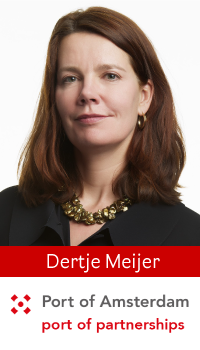'Innovate, respond to market developments and listen to what customers want'

You studied Business Administration at the University of Groningen. What made you choose this particular degree programme?
I have affinity with technology and this programme combined my interest with a chance to find out more about how businesses and people work. Groningen is a fantastic city for students. Moreover, at the time there were only two universities offering Business Administration: the University of Twente and the University of Groningen.
How do you look back on your time at university?
It was a happy time, in which I learned a lot. I still come to Groningen regularly and even though I left years ago, it still feels like coming home. All the theory I learned during my programme also works well in practice. I still feel the benefits of my knowledge every single day. The most useful skills I acquired during the programme were social skills, learning to achieve joint results and developing a proper understanding of the course material and set theory.
In your presentation, you will discuss the changing role of the Port Authority, the Visie 2030. Which changes is the Port Authority currently facing?
Technological developments and the knock-on effects they entail, and above all, the opportunities and enormous changes this brings to the port, the logistics, the industry and the people. How should we prepare for this? How will the organization and our customers react if we transfer some of our maritime guidance activities to drones, for example?
How is the Port Authority responding to these changes?
To paraphrase Darwin: it is not the strongest that survives; it is the one that is most adaptable to change. So we must innovate, respond to market developments and, most importantly, listen to what our customers want. You won’t survive if you don’t innovate in time. Take a firm like Kodak, for example, which had all the technological know-how it needed to make the transition to digital photography, but hung on to analogue for too long.
You say that the Port of Amsterdam wants to become a network port. What do you mean by this and how will it work in practice?
The port is a juncture between three pivots: the port as an international hub, the metropolis of Amsterdam and the industry. Our role as a port is to connect these three pivots in order to enable innovation and ‘create ground-breaking value’, as it says in our mission statement.
Innovations are realized at the juncture of the three pivots of the Visie 2030, in which you set out your ideas for the future of the Port of Amsterdam. What sort of innovative projects do you have in mind?
It’s all about innovation in four areas: the circular economy, energy transition, logistics and security & surveillance. A couple of examples from the field: recovering phosphate from urban sewage water and obtaining biodiesel from frying fat collected from urban cafés and restaurants. Or with regard to security and surveillance: the use of sensors in ships’ berths.
Visie 2030 makes particular mention of the circular and bio-based economy. What is the role of the Port Authority in this respect?
A circular economy means no waste. Waste is a raw material for industries; it is used to make or produce other products. For example, oil is used to make plastic and plastic is used to recover oil. The Port’s role to make link between flows and companies and to get initiatives off the ground.
